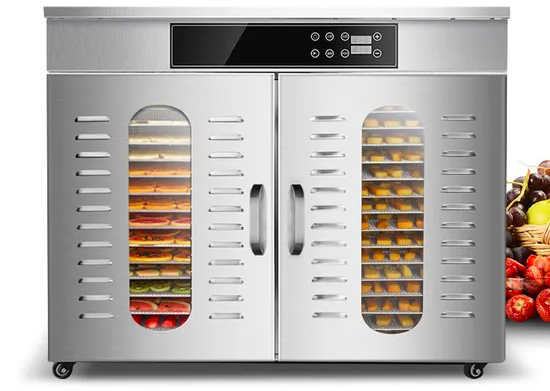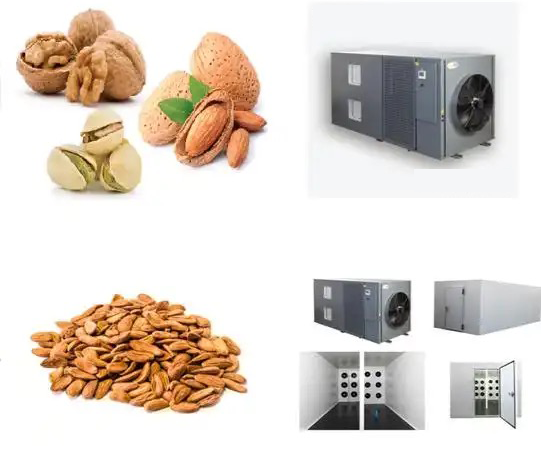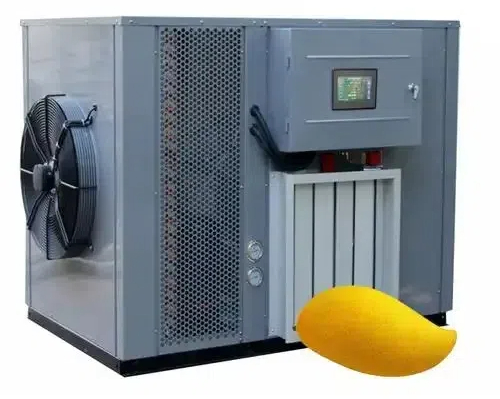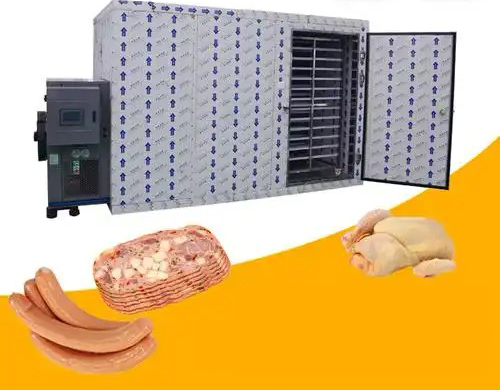
Content Menu
● What is a Food Dehydrator?
● Benefits of Using a Food Dehydrator
● Types of Food Dehydrators
● Key Features to Consider
● How to Use a Food Dehydrator
● The Role of Heat Pump Dryers in Food Preservation
● Common Misconceptions About Food Dehydration
● Popular Foods to Dehydrate
● Tips for Successful Dehydration
● Storing Dried Foods
● Conclusion
● Related Questions
>> 1. What types of foods can be dried using a food dehydrator?
>> 2. How long does it take to dehydrate food?
>> 3. Can I use my oven instead of a dehydrator?
>> 4. How should I store dehydrated foods?
>> 5. Are there any safety concerns with using a food dehydrator?
Food dehydrators have become increasingly popular in recent years, especially among health-conscious consumers and those looking to preserve food for longer periods. This article will explore the different types of food dehydrators, how they work, their benefits, and considerations for choosing the right model. Additionally, we will touch on the relevance of heat pump dryers and their tax credits, as they relate to energy efficiency in food preservation.

What is a Food Dehydrator?
A food dehydrator is an electrical appliance designed to remove moisture from food to preserve it. By lowering the moisture content, dehydrators prevent the growth of bacteria, yeast, and mold, thereby extending the shelf life of various foods.
How Does It Work?
Food dehydrators operate by using a combination of heat and airflow to evaporate moisture from food items. The process involves:
- Heat Source: The dehydrator has a built-in heating element that raises the temperature inside the unit. This heat is crucial for drawing out moisture.
- Airflow: A fan circulates warm air evenly throughout the dehydrator, ensuring uniform drying. Proper airflow is essential to prevent spoilage and maintain nutritional value.
- Trays and Racks: Food is placed on trays or racks that allow air to circulate freely around it.
- Temperature Control: Most modern dehydrators come with adjustable temperature settings and timers, allowing users to customize the dehydration process based on the type of food being preserved.
Benefits of Using a Food Dehydrator
Using a food dehydrator offers numerous advantages:
- Preservation of Nutrients: Dehydration retains most vitamins and minerals compared to other preservation methods like canning or freezing.
- Extended Shelf Life: Dehydrated foods can last for months or even years when stored correctly.
- Cost-Effective: Buying produce in bulk when in season and dehydrating it can save money over time.
- Healthy Snacking: Dried fruits and vegetables make nutritious snacks without preservatives or added sugars.
- Versatility: Dehydrators can be used for a wide range of foods, including fruits, vegetables, meats, herbs, and even pet treats.
Types of Food Dehydrators
There are two main types of food dehydrators:
1. Stackable Dehydrators: These feature several trays stacked on top of each other with a heating element at either the top or bottom. They are often more budget-friendly but may require manual rotation of trays for even drying.
2. Vertical or Box-Type Dehydrators: Known for their efficient design, these units have a vertical heating element and fans located at the back. They provide more even drying without needing to rotate trays frequently.

Key Features to Consider
When choosing a food dehydrator, consider the following features:
- Temperature Control: Different foods require different drying temperatures; adjustable settings are crucial.
- Timer Functionality: A timer allows you to set the dehydration process and carry on with other tasks without worrying about over-drying.
- Capacity: Depending on how much you plan to dehydrate at once, consider the number of trays or shelves available.
- Noise Level: Some dehydrators can be quite noisy; look for models designed for quieter operation.
- Material Quality: Stainless steel trays are more durable than plastic ones and may be preferable for long-term use.
How to Use a Food Dehydrator
Using a food dehydrator is straightforward:
1. Prepare Your Food: Wash and slice your fruits or vegetables into uniform pieces for even drying.
2. Arrange on Trays: Place the food on the trays without overcrowding them to allow air circulation.
3. Set Temperature and Time: Adjust the settings according to your specific food item (e.g., fruits may require lower temperatures than meats).
4. Monitor Progress: Check periodically to ensure even drying; rotate trays if necessary (for stackable models).
5. Store Properly: Once dried, store your food in airtight containers in a cool, dark place.
The Role of Heat Pump Dryers in Food Preservation
Heat pump dryers are an innovative solution for drying foods efficiently while minimizing energy consumption. They work similarly to traditional dryers but use heat pump technology to recycle hot air within the system. This method not only reduces energy costs but also helps maintain the quality of dried foods by preventing overheating.
Tax Credits for Heat Pump Dryers
In recent years, various tax credits have been introduced to encourage energy-efficient appliances' adoption, including heat pump dryers. Homeowners can benefit from significant savings when installing these systems due to federal incentives aimed at reducing energy consumption and carbon footprints.
For example:
- Homeowners can claim up to 30% of installation costs as tax credits.
- The maximum credit amount can reach up to $2,000 depending on specific conditions met during installation.
These incentives make investing in heat pump dryers not only environmentally friendly but also economically advantageous.
Common Misconceptions About Food Dehydration
Despite its benefits, there are several misconceptions about food dehydration that often deter people from using this preservation method:
- Dehydration Destroys Nutrients: While some nutrient loss may occur during dehydration, it is generally minimal compared to other methods like boiling or frying. In fact, many nutrients remain intact when dried properly.
- Dried Foods Are Unhealthy: Many believe that dried foods are unhealthy due to added sugars or preservatives; however, when done at home using a dehydrator, you control what goes into your snacks.
- Dehydration Is Complicated: Many people think that using a dehydrator requires special skills or knowledge; however, with a bit of practice and following guidelines, anyone can effectively dehydrate food at home.
Popular Foods to Dehydrate
Some popular foods that work exceptionally well in dehydrators include:
- Fruits: Apples, bananas, strawberries, mangoes, and pineapples are favorites for their sweetness and ease of drying.
- Vegetables: Carrots, zucchini, bell peppers, and tomatoes can be dried for use in soups or snacks.
- Herbs: Basil, thyme, oregano, and parsley retain their flavors well when dried.
- Meats: Jerky made from beef or turkey is a popular high-protein snack option.
- Nuts and Seeds: While not typically dried in a dehydrator (as they are already low in moisture), some prefer lightly roasting nuts before storing them for enhanced flavor.
Tips for Successful Dehydration
To maximize your dehydration efforts:
1. Use Fresh Produce: Always start with high-quality fresh fruits or vegetables; overripe produce will not dry well.
2. Uniform Slicing: Cut your food into uniform pieces so they dry evenly.
3. Pre-Treat When Necessary: Some fruits benefit from pre-treatment (like soaking in lemon juice) to prevent browning.
4. Rotate Trays if Needed: For stackable models, rotate trays halfway through the drying process for even results.
5. Test for Doneness: Check your food periodically; it should be dry but still pliable (not brittle).
Storing Dried Foods
Proper storage is crucial for maintaining the quality of your dried foods:
- Use airtight containers such as glass jars or vacuum-sealed bags.
- Store in cool dark places away from light and moisture.
- Label containers with dates so you know when they were dried; consume older items first.
Conclusion
Food dehydrators offer an effective way to preserve food while retaining its nutritional value. With various types available on the market today, consumers can choose models that best fit their needs based on capacity, features, and price points. Additionally, understanding how heat pump dryers work alongside available tax credits can further enhance energy efficiency in food preservation practices.
By investing in both food dehydrators and energy-efficient appliances like heat pump dryers, consumers can enjoy healthier eating options while contributing positively to environmental sustainability efforts.

Related Questions
1. What types of foods can be dried using a food dehydrator?
You can dehydrate various foods such as fruits (apples, bananas), vegetables (carrots, tomatoes), meats (beef jerky), herbs (basil), and even sauces like fruit leathers.
2. How long does it take to dehydrate food?
Dehydration times vary depending on the type of food and thickness; generally, it can take anywhere from 4 hours up to 24 hours for complete dehydration.
3. Can I use my oven instead of a dehydrator?
Yes, you can use an oven set at low temperatures (around 140°F) as an alternative for drying foods but may not achieve the same efficiency as dedicated dehydrators.
4. How should I store dehydrated foods?
Store dehydrated foods in airtight containers in cool dark places; vacuum sealing is ideal for long-term storage.
5. Are there any safety concerns with using a food dehydrator?
Ensure that you follow guidelines regarding temperature settings and drying times to prevent spoilage or bacterial growth; always wash your produce before dehydration.












